
Concept explainers
a)
To determine: The maximum number horse sculptures that can be made in an hour.
a)
Explanation of Solution
Given information:
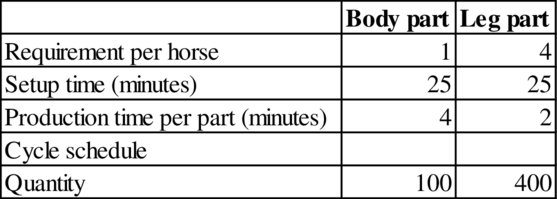
Calculation of maximum number of horses:

Formula:
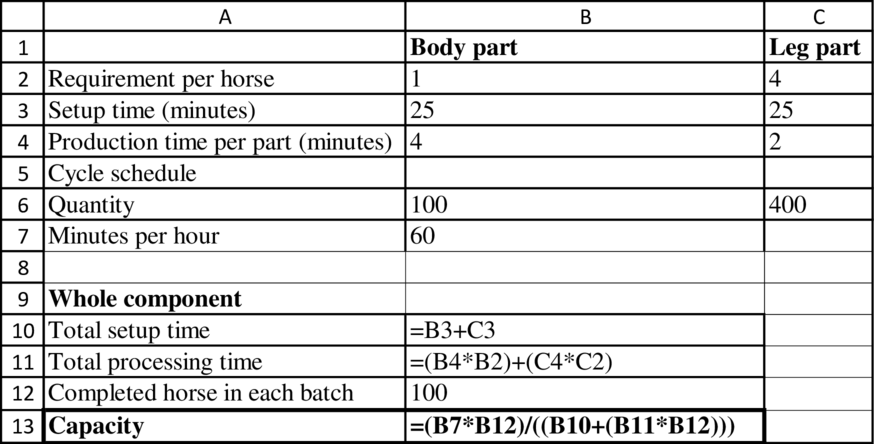
The maximum number of horse sculptures made in an hour is 4.8.
b)
To determine: The utilization % of the lathe.
b)
Explanation of Solution
Given information:
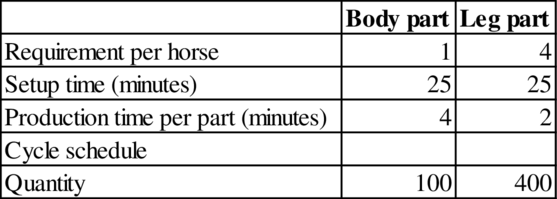
Calculation of utilization of lathe:
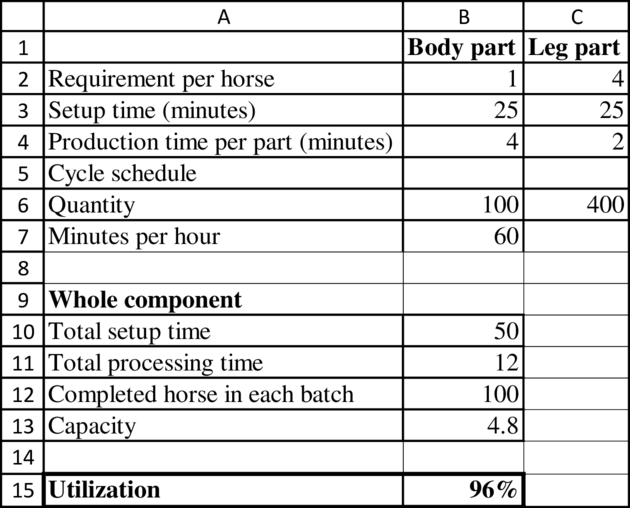
Formula:
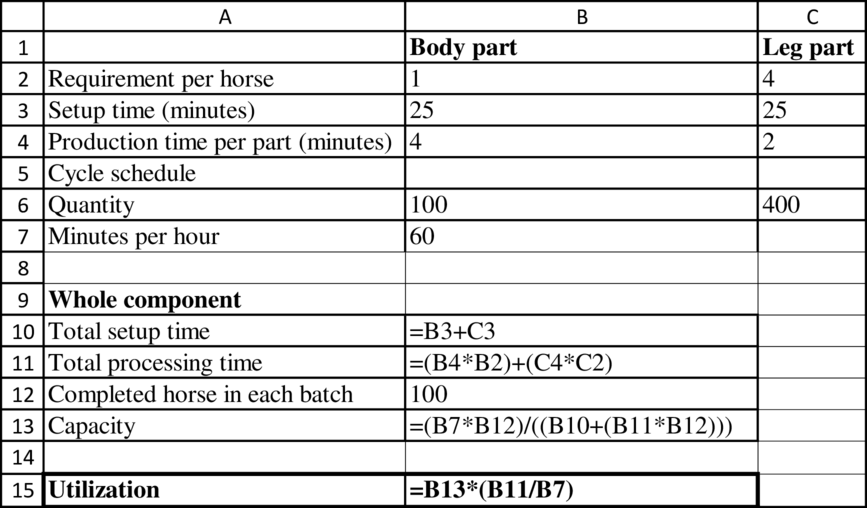
The utilization of lathe is 96%.
c)
To determine: The average inventory of body parts.
c)
Explanation of Solution
Given information:
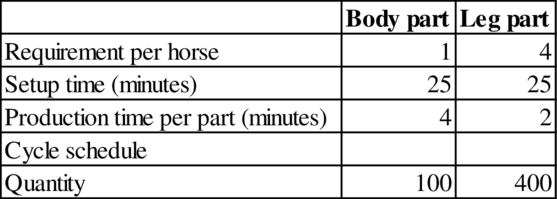
1 worker can assemble the horse sculpture in 16 minutes.
Calculation of flow rate:
Calculation of average inventory:
The total batch size of legs is 100 and the processing time is 4 minutes.
The average inventory is 37.5 body.
d)
To determine: The average inventory of leg parts.
d)
Explanation of Solution
Given information:

1 worker can assemble the horse sculpture in 16 minutes.
Calculation of flow rate:
Calculation of average inventory:
The total batch size of legs is 400 and the processing time is 2 minutes.
The average inventory is 100 legs.
e)
To determine: The number of body parts that needs to be made to minimize the inventory while not constraining the flow through the assembly.
e)
Explanation of Solution
Given information:
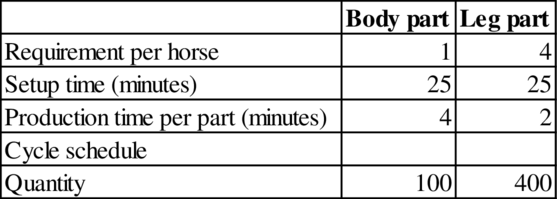
1 worker can assemble the horse sculpture in 16 minutes.
Calculation of batch size:
The target capacity is the flow rate at 3.75 sculptures per hour. There is 1 body in each component set. Therefore, the batch size will be:
The body parts batch size is 12.5 body.
f)
To determine: The number of leg parts that needs to be made to minimize the inventory while not constraining the flow through the assembly.
f)
Explanation of Solution
Given information:
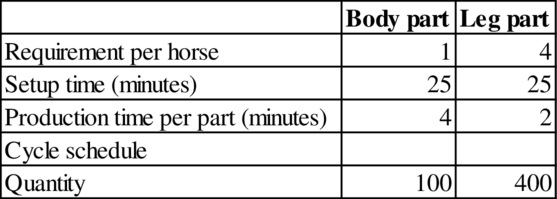
1 worker can assemble the horse sculpture in 16 minutes.
Calculation of batch size:
The target capacity is the flow rate at 3.75 sculptures per hour. There is 4 body in each component set. Therefore, the batch size will be:
The leg parts batch size is 50 leg.
Want to see more full solutions like this?
Chapter 7 Solutions
OPERATIONS MANAGEMENT
- 1) Read “Walmart Focuses on its Supply Chain” (page 670 in the text) and answer the following questions: a) What improvements has Walmart made to its supply chain system? b) What competitive advantages might Walmart have over Amazon? 2) View the YouTube video How the Mumbai Dabbawalas Work? (3.16 minutes, Ctrl + Click on the link, there are also many longer video clips available on the Internet) and answer the following questions: https://www.youtube.com/watch?v=KDD32skx-zM a) How do the Mumbai Dabbawalas achieve their high service performance? What factors facilitate the success of their distribution network? b) If you want to “modernize” the dabbawalla distribution network, what changes (and why) will you make to the system? a) Retail outlets that do not have an internet presence often complain that consumers come in to “kick the tires,” but then buy online from a competitor. Can you suggest some ways outlets can overcome this challenge? b) Some customers of…arrow_forwardKindly assist with writing the project plan for this A smart mobile platform to boost entertainment event attendance and optimise venue management using geolocation and user engagement analyticsarrow_forwardNote: Please make sure you label your answers. 2a. Complete the following Make or Buy Analysis. Make or Buy Analysis Food Cost Processed chopped lettuce • $23.80/case of 4, 5 lb. bags • Price/lb Whole head lettuce $16.49/50 lb case • Price/lb AP • 75% yield on whole head lettuce • Price/lb EP Labor Cost Processed chopped lettuce ⚫ No labor cost Whole head lettuce • Cooks are paid $10.85/hr with 20% benefits • It takes 2 hours to process 50 lbs. of lettuce • Benefits • Cook labor cost with benefits • Total labor cost for 1 lb. lettucearrow_forward
- analysis needs to address the following issues: The battery temperatures are a major concern for us. Can you analyze and describe the sample data? What are the average and median temperatures? How much variability is there in the temperatures? Is there anything that stands out? Our engineers’ assumption is that the temperature data is normally distributed. If that is the case, what would be the likelihood that the Safety Zone temperature will exceed 5.15 degrees? What is the probability that the Safety Zone temperature will be less than 4.65 degrees? What is the actual percentage of samples that exceed 5.25 degrees or are less than 4.75 degrees? Is the manufacturing process producing units with stable Safety Zone temperatures? Can you check if there are any apparent changes in the temperature pattern? Are there any outliers? A closer look at the Z-scores should help you in this regard.arrow_forwardFactor Factor Description Weight Present Location Newbury Hyde Park 1 Average community income 0.35 2 Community growth potential 0.15 3 Availability of public transportation 0.20 4 Labor availability, attitude, and cost 0.30 3 2 3 2 35 20 25 75 33 28 55 55 25 75 65 50 50 55arrow_forwardSubway with more than 27,000 outlets in the US is planning for a new restaurant in Buffalo New York. A) Based on the given information, the best location in Buffalo for Subway to open the new restaurant is Baptist Church with a total weighted score of? (Enter your response rounded to two decimal places.) B) If the weights for Space and Traffic density are reversed, the best location in Buffalo for Subway to open the new restaurant will be with a total weighted score of ? (Enter your response rounded to two decimal places.)arrow_forward
- northeastern insurance company is considering opening an office in the US. The two cities under consideration are going to be Philadelphia New York. Factor ratings (higher scores are better) are in the table. The best location for northeastern insurance company to open would be which with a total weighted score of ? (response rounded to two decimal places)arrow_forwardWhen football fans watch a game, they believe the other side commits more infractions on the field than does their own team. This favoritism can best be termed _____. Group of answer choices A. ethnocentrism B. the fundamental attribution error C. the affiliation bias D. marginalizationarrow_forwardWhen football fans watch a game, they believe the other side commits more infractions on the field than does their own team. This favoritism can best be termed _____. Group of answer choices ethnocentrism the fundamental attribution error the affiliation bias marginalizationarrow_forward
- Which of the following best describes the differences between egalitarianism and hierarchy as cultural values in negotiation? Group of answer choices A. Egalitarian cultures communicate directly; hierarchical cultures communicate indirectly. B. Egalitarian cultures treat people equally; hierarchical cultures discriminate among people. C. Egalitarian cultures divide things equally; hierarchical cultures divide things according to merit and status. D. Egalitarian cultures believe that status is permeable through effort and achievement; hierarchical cultures believe that superiors should take care of the needs of subordinates.arrow_forwardWhich of the following best describes the differences between individualism and collectivism as cultural values in negotiation? Group of answer choices A. Individualists see themselves as autonomous entities; collectivists see themselves in relation to others. B. Individualists prefer to work in groups; collectivists prefer to work alone. C. Individualists are cooperative; collectivists are competitive. D. Individualists focus on relationships; collectivists focus on money.arrow_forwardWhen it comes to resolving conflict, managers from hierarchical cultures prefer _____. Group of answer choices A. to attribute a disagreeable person's behavior to an underlying disposition and desire formal dispute resolution procedures B. an interests model that relies on resolving underlying conflicts C. to regulate behavior via public shaming D. to defer to a higher status personarrow_forward
 Practical Management ScienceOperations ManagementISBN:9781337406659Author:WINSTON, Wayne L.Publisher:Cengage,
Practical Management ScienceOperations ManagementISBN:9781337406659Author:WINSTON, Wayne L.Publisher:Cengage,
